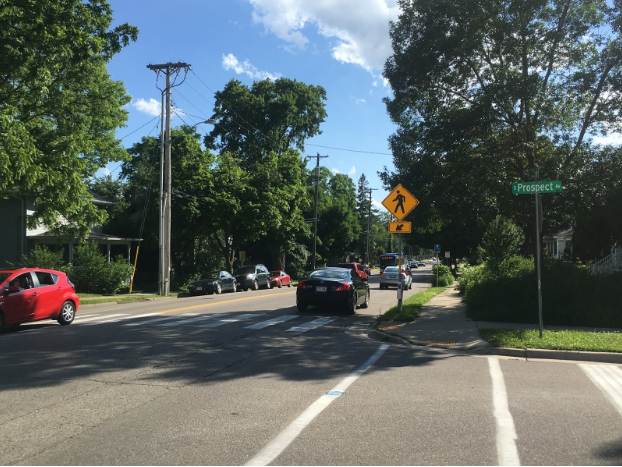






 One of the busy intersection on Monroe where a RRFB will be installed. (Maija Inveiss/Madison Commons)
One of the busy intersection on Monroe where a RRFB will be installed. (Maija Inveiss/Madison Commons)
The City of Madison hosted the Monroe Street Reconstruction kick-off meeting Monday to introduce the planned pedestrian changes and to gather public opinion.
Monroe Street Reconstruction was previously postponed and rescheduled, but the city plans to start reconstruction in 2018. The meeting was designed to re-introduce the ideas from community discussions in 2014.
The majority of people at the meeting were neighbors of Monroe Street, local business owners, city staff, neighborhood association members and the engagement resource team. The ERT is a group of stakeholders who will attend more meetings as representatives of various community stakeholders.
To help facilitate public conversation, the city hired Urban Assets, a local Madison consulting firm. Zia Brucaya, the associate planner at Urban Assets, introduced five main organizing themes that will be used throughout the planning process: pedestrian safety and access, green infrastructure, bicycle safety and access, business enhancement and transit safety and access. These organizing themes are based off of input from community members in 2014 and the changes they wanted to see.
Jim Wolfe, the city project engineer for Monroe Street Reconstruction, said the city will start improving pedestrian safety this summer through the installation of rectangular rapid flash beacons (RRFBs), solar-powered signs that notify drivers of a pedestrian crosswalk.
“We want these things to turn on. We got bright strobe lights. These are going to make it very obvious that somebody’s crossing the street there,” Wolfe said.
These will be installed on intersections of Harrison Street, Prospect Avenue, Edgewood Avenue, Western Avenue, Odana Road and either Knickerbocker Street or Sprague Street. Wolfe said RRFBs are a cost-effective, interim solution to the pedestrian issues on Monroe Street, one of the main concerns from Monday’s meeting and previous meetings.
When the reconstruction officially begins, Wolfe said the budget allocates funds for other improvements for pedestrians. Some of those changes might be improved crosswalk markings, countdown timers on signals and overhead flashing signs.
The current budget is approximately $17 million with the majority going towards infrastructure, lighting and signals, pavement markings, pedestrian improvements and possibly closing Crazy Legs Lane to cars. Other parts of the budget focus on the sewer main, water main, storm sewers, water quality and rain gardens.
Over next year and a half, there will be more time for public engagement and discussion. This summer the project timeline focuses on refining the vision, goals, issues and opportunities for Monroe Street as well as collecting more data.
District 13 Alder Sara Eskrich said she feels hopeful about the opportunity the community has to discuss the changes made to Monroe Street, since it is an integral part of Madison.
“Monroe Street is the connection to all of us who live in this area, it’s something that we interact with on a daily basis,” Eskrich said. “We use this public space in our daily lives, so it’s really important how we and how the rest of the community, more broadly, uses monroe street and how reconstruction impacts the future of this city.”
|
|
|
Welcome to the Madison Commons, a website designed to provide news and information about all of Madison's neighborhoods and a crossroads for the discussion of community issues. The name comes from the idea of a village commons, a place for news, talk, debate, and some entertainment, too, that's open to everyone.
All rights reserved. Read more about the Madison Commons and its partners.

